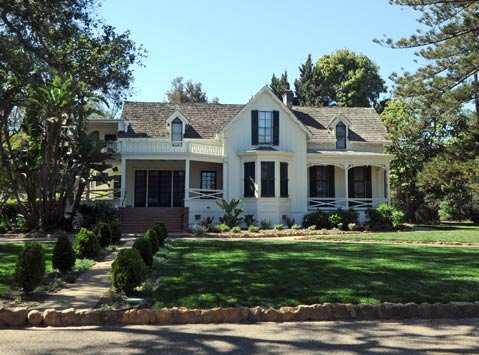Stow House Gardens Restoration
Arboretum at Historic Ranch Returned to 1880s Glory

Some people say time travel is impossible. Well, those people have never been to Rancho La Patera. Not that you’ll be rubbing elbows with Sherman Stow, patriarch of the Stow House, as you stroll the grounds, but once the Arboretum Restoration project – which aims to return the gardens to their 1880s splendor – is complete, all that will be missing is Sherman himself.
Rancho La Patera harks back to an era when only birds made tweets and an instant message was sent in Morse code. Purchased in the summer of 1871 by William Whitney Stow, the 1,042 acres of exceptionally fertile Goleta Valley land were given to his son, Sherman, to build a home and develop into farmland. Two years later, Sherman and his wife, Ida, moved into their new home. Along with planting almonds and other crops, Sherman’s big financial break came in 1875 when 3,000 lemon trees were placed in the first commercial lemon orchard planting in California, a crop now inextricably linked with Goleta.
Though the landscape was dominated by the orchards, closer to home, the Stows fervently experimented with interesting horticultural displays and experiments, inspired by the European model of “the picturesque,” or specimen, garden. Typical of the late 1800s, these gardens served as status symbols to show off to guests or meander through thoughtfully. The focus of the Stow garden was exotic and unusual plants from around the world, including the delightfully named bunya-bunya and the noble Moreton Bay chestnut, among many others. However, the most interesting tree in the collection is one of immense sentimental value. In 1874, Sherman gave Ida a single redwood seed in a coffee tin as a symbol “of the growth of their family.” He could not have picked a better gift; today it is one of the tallest – if not the tallest – trees on the property.

the Arboretum Restoration project, when completed, the garden should be eligible for recognition as a historic cultural landscape.
Since 1967, the Goleta Valley Historical Society (GVHS) has kept the past present as stewards of the Goleta Valley and the Stow family. This involves recreating and preserving the property as faithfully to its past as possible, most recently restoring the parking shed in 2006. Now, after years of intense and meticulous planning, the GVHS has finally broken ground on the first phase of the Arboretum Restoration Project.
The project is part of a 25-year plan to restore the ranch to its late-1800s state, according to Amanda De Lucia, director and project manager. Needless to say, it is a massive undertaking. In 2007, several cultural and landscape historians and architects were contacted to analyze a multitude of photographs and some written recordings, as well as the property itself, to take an inventory of all the plants on the property. As De Lucia put it, “There was no guesswork involved.”
Once the plants were cataloged, phase one could begin. As the most intense part of the project, phase one involved getting the infrastructure for the garden in place, including reinstalling pathways that once traversed the original arboretum and replacing the decades-old sprinklers with a modern irrigation system. With regard to the plants themselves, professionals have been thoroughly scouring the fenced-in sections of the grounds, saving and reusing bulbs of the original gardens and taking out those that aren’t “historically accurate.” Phase two will expand the restoration beyond the fences, and phase three will effectively tie up all the loose ends, heralding the project’s completion.
If all goes according to plan, the gardens will then be eligible for nomination to the National Register of Historic Places for cultural landscape, an honor that Stow House received in 2000. The GVHS has taken it upon itself to “freeze it in time,” because, as De Lucia said, “If this wasn’t here … a piece of history would have been totally lost. Once it’s gone, you can’t get that back.”
However, the project is about more than achieving national recognition as a historical place; it’s also about preserving a piece of living history. Like Sherman Stow planting the redwood seed, his symbol of love that withstood the test of time, the Goleta Valley Historical Society is doing the same with the Arboretum Restoration in the hope that its labor of love will help the ranch remain in perpetuity.
4•1•1
Rancho La Patera is located at 304 North Los Carneros Road, Goleta. For more information, call 681-7216 or visit stowhouse.com.



